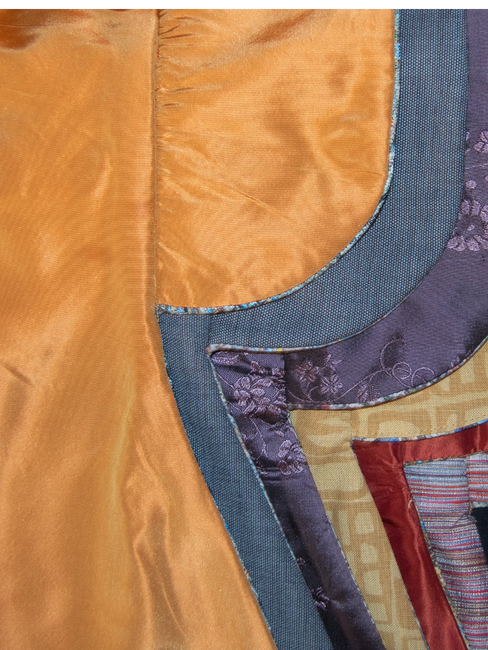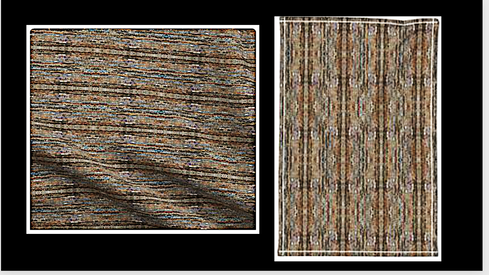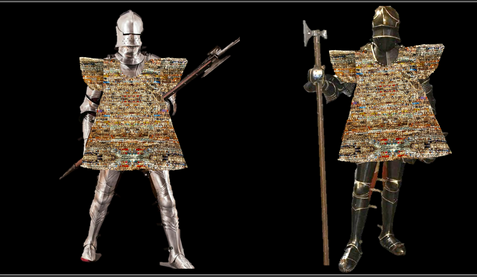Tabards of Place: Cloth as Memory Mosaic
- vmramshur
- Jun 25
- 5 min read
Updated: Jul 7
Each piece is a place.Each piece is a passage.
This marks the first of two final projects from my sabbatical year. If you've been following this blog, you'll know that themes like landscape, historical garments, color, and memory often recur—along with identity and heraldic symbols representing both self and place. For a more in-depth discussion on these themes, please refer to earlier posts.
What if memory could be worn? What if place could be stitched into form?
Tabards of Place originated from those inquiries. It represents one of the concluding projects central to this sabbatical, during which I transformed my travel and research photography, along with color studies, into wearable textile mosaics.
These are photo mosaics in textile form, they are telling stories of color, location, and memory stitched into being. They capture the hues, textures, and emotional temperature of a place. From sun-bleached marble to deep harbor blue, these tabards trace lived experience through fabric and light.
Drawing from the historical language of heraldry, loyalty, and identity, the tabard is re-envisioned as a tactile canvas where individual and cultural narratives come to life, featuring stitched photographs, layered textures, and embedded symbols. By mirroring and repeating thousands of my photographic images, new patterns are created. Similar to an Anatolian carpet, a distorted reflection on the water, or a kaleidoscope, repetition transforms into a new narrative.
The tabards become intimate canvases, portable storyboards that blend costume history with contemporary textile art. Their compact size invites closeness, while still allowing for rich visual layering and symbolic detail. Each tabard distills the essence of a place: its colors, materials, and emotional resonance.
These are not costumes in the usual sense. They serve as symbols. Comprising six half-scale tabards and one full-size garment made with custom fabrics designed from my travel and research photos taken in Croatia, Turkey, and Venice. Sun-bleached walls, watery greens and blues, terracotta rooftops, mosaic floors, diverse museum exhibits, markets and meals, places of worship, and material objects were transformed into palette, pattern, and texture.
Process: Research
Upon returning from my travels, I spent the autumn months delving deeper into the study of the tabard and medieval garments throughout Europe and the eastern Mediterranean. The Metropolitan Museum at the Cloisters' library and galleries, combined with images I captured across Europe during my journey, led me to discover monumental brasses, paintings, and written descriptions of these garments, which proved to be invaluable resources. I was thankful for my basic proficiency in French, Spanish, and German, and, to be completely honest, for Google Translate when dealing with more complex texts. This allowed me to translate these sources. Equipped with images, sketches, and comprehensive research, I finally decided on the shape I desired. This was a challenging task, as tabards evolved over the centuries and were worn by warriors, workers, and worshippers alike.
Process: Fabric Creation

Hours spent in my basement studio pouring over thousands of images taken on my travels. Working with online vendors Spoonflower and Contrado, along with their excellent customer service representatives (whom I contacted daily with inquiries), I started designing photo mosaic textiles by altering my images and contact sheets.
The choice of fabrics symbolically represents the countries from which the images come: cottons, silks, linens, and velvets. Likewise, the lining fabrics I selected mirror the textiles used in the specific countries shown in the photographs. An important note: all fabrics used for linings were upcycled and repurposed from thrift shops and donations from theatrical costume shops like Eric Winterling Costumes, and my own MGSA/Rutgers Costume Shop for which I am very grateful.
Fabrics: On the left, linings for the tabards; on the right, samples of custom digitally printed textiles created. photo by Emily Knapp
Process: Construction
The process evolved into a highly collaborative effort. I partnered with my close friend, patternmaker, and researcher Maggie Raywood, to develop a shape inspired by a 15th-century Burgundian marshaling tabard. Her expertise in patterning four types of tabards, which are historically based yet flexible enough for this design, was invaluable. We focused on interpreting images and recreating details and shapes, ultimately deciding on one shape for all seven garments.
Maggie Raywood developing garment "mock-ups" to comprehend both my sketch and the historical research on how this seemingly "simple" garment was constructed.
Once the forms were completed and tabard patterns created, designer and costume technician Emily Knapp brought each tabard to fruition. With custom printed textiles, Emily's creative skill and precision were crucial for both pattern alignment and construction, enabling the images to come alive. Each garment used a different type of fabric, so the construction of the tabards had to adapt to the specific requirements and challenges of each textile. It was no simple task.
Emily Knapp is working on matching the pattern for a full-size "Venetian" tabard lining. Photos by Emily Knapp
Process: Completion
Completing the garments involves further examining the process and my strategy. The challenge I face (and continue to struggle with) is determining whether to add more embellishments. My usual approach favors heavy surface decoration, but this can overshadow the fabric. In this case, the mosaic acts as both the narrative and the embellishment. Letting the image take center stage was a new discipline for me.
Final Garments:
Bodrum, Türkiye
Istanbul, Türkiye
Republic of Türkiye
Konavle Valley, Croatia
Republic of Croatia
Island Of Burano, Italy
Venice, Italy
This post includes images of the tabards as they are being created, along with some of the photos that inspired them. It features swatches, sketches, and tests that informed my decisions as we transitioned from a 2D sketch/photo to a 3D textile object. Numerous notebooks were filled with sketches, research, and images. What might seem like a straightforward project was far from it. With an exhibition in preparation, all elements will be combined to showcase this journey.
Gratitude for the Team:
I am immensely thankful to Maggie Raywood and Emily Knapp. Their intelligence, collaborative discussions, and exceptional work were indispensable. Collaborating with Maggie, a mentor and professor of mine, and Emily, a former student and MGSA/Rutgers alum, enabled us to transition from academia to the artistic sphere—a dream realized for me. Their passion for this project kept me motivated, along with numerous pots of tea. Emily, I also appreciate your photographs.
Historical Pattern Recreation by Maggie Raywood, Adapted from an extant 15th-century Burgundian marshaling tabard.
Construction of Final Tabards by Emily Knapp, Historical Garments realized using modern fabrication techniques.
Closing Thought
By carrying a place with us through fabric and stitch, we breathe new life into it. Occasionally, it returns the favor.
-Val
Inspiration: Left: Still life at Su Hotel Bodrum, Türkiye Right: Dried Vegetable Stand in Kadıköy, Istanbul, Türkiye
Sources for Fabric Printing:
Spoonflower: https://www.spoonflower.com/
Contrado: https://www.contrado.com/
Next week: Project: Invisible Vestments

































































































Truly wonderful collaboration. What a great way to bring all your travels, research, work and artistry into a series of tangible work. Questions -
Who did the 3D illustrations? They're fab.
What textile did you use for the digital printed fabrics? The CS for both those companies is to be applauded. They're wonderfully patient and helpful.
Brava!
Beautiful work Valerie rich with informative research and thorough, thoughtful process. Thank you.